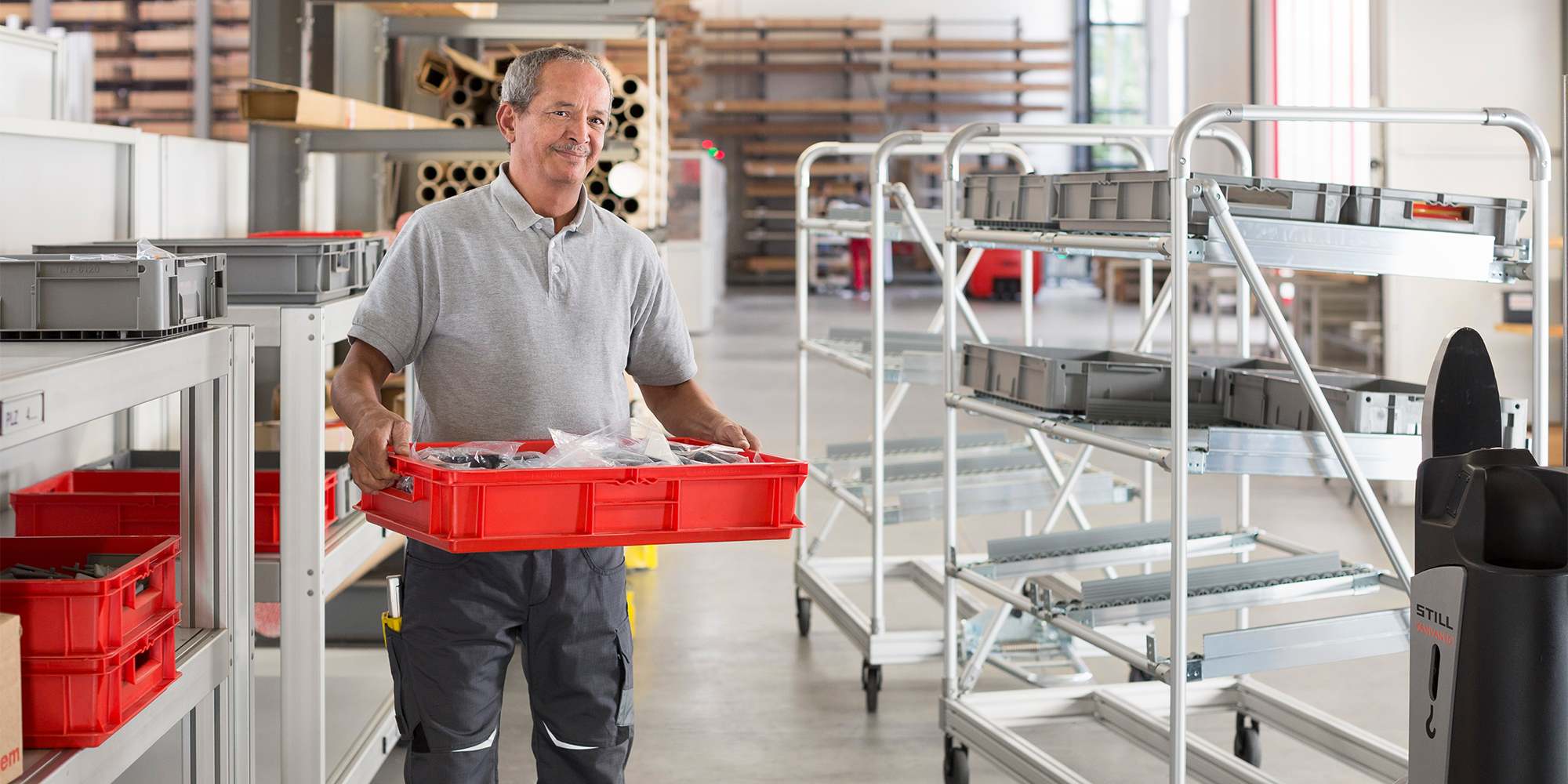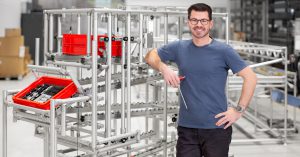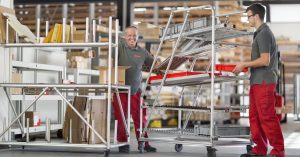The interplay of components and online software creates the perfect basis for customised tugger train solutions.
Tugger trains are ideal when it comes to regular, predictable parts delivery for production. They are made up of a towing vehicle (tractor unit), goods carriers (systems for accommodating the load carriers with the conveyed loads) and load carriers (such as pallet carts or trolleys). The safety, efficiency and reliability of tugger trains make them a vital component of lean production. However, companies need to have the possibility of easily adapting such constructions to the existing conditions and making further modifications should changes in production require it. Constructions that use the item building kit principle are perfect in this situation. The modular components provide scope for many variants and possible combinations. The item Engineeringtool is a particularly quick and convenient way of creating customised frames and superstructures for tugger trains.
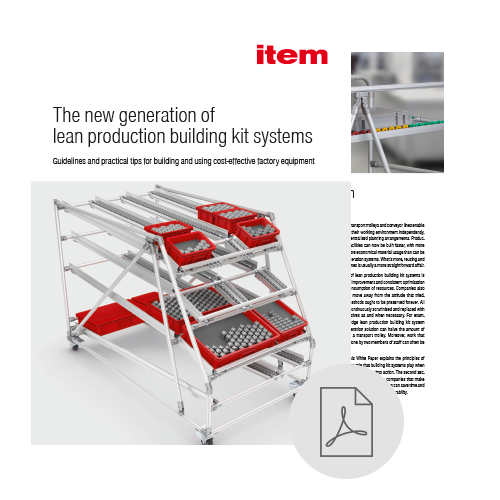
The world of lean production
Less waste and more added value – lean production methods help you make targeted improvements to your production efficiency. Our white paper provides a concise introduction.
GET YOUR COPY NOW!
Where and how are tugger trains used?
There is a huge range of potential uses for tugger trains. They can be found in settings as diverse as automotive industry companies, logistics providers, railway stations and airports. They transport materials and production resources from storage facilities to various supply points – generally assembly areas or production lines. Furthermore, they are the method of choice for optimising material flows and designing leaner, more efficient processes. Tugger trains ensure that even small batch volumes get to the right place at the right time and in the right order. They do more than simply collect and deliver parts and materials in a circuit at specific intervals – they also collect and return empty containers. Imagine it like a milk round. The milkman brings full bottles to various destinations, and collects the empty bottles at the same time. This is why the equivalent in-house logistics procedure is known as the milk run method. The Kanban method comes to the fore for controlling the entire material flow. Individual steps are carried out in a specific order. A restock is only ordered when supplies start to run low. As a result, bottlenecks and oversized inventories can be avoided.
Frames and bases for the perfect tugger train
The biggest thing when it comes to tugger trains is flexibility. Requirements can vary hugely – especially as these can change quickly as a result of new work processes or production conditions in the company. For this reason, it is essential to custom design tugger trains, and for it to be possible to modify them at any time. “Welded systems soon show their limits in this regard. Our system, which is made using aluminium profiles and appropriate fasteners, produces frames that can be easily changed at any time,” says Axel Mohr, product manager at item. Here, too, the building kit system philosophy that has been so successful for decades really proves its worth. All the components are mutually compatible and can therefore be combined flexibly. Since the aluminium profiles are screwed together, superstructures can easily be dismantled without destroying them. Both standard constructions (for euro pallets or mesh crates, for example) and unique superstructures and tugger train solutions can be created quickly and easily. The characteristics of the aluminium profiles mean the constructions have outstanding rigidity and are extremely robust.

Designing goods carriers and more – comprehensive range of components for customised solutions
The MB Building Kit System and the Lean Production Building Kit System include numerous components that are ideal for constructing tugger train solutions. The many different variants of Swivel and Fixed Castors enable perfect rolling and handling. These are fastened directly to the grooves of the support frame. The Castors are easily released and moved, making them flexible to install. The central alignment and anti-torsion feature of the Fixed Castors mean they provide optimum directional stability. Castors from item withstand loads of up to 500 kilograms, and in some cases are available as an ESD-safe version. Tugger trains fitted with these Castors can achieve speeds of up to 16 km/h. The Drawbars and Couplings from the MB Building Kit System are perfect for connecting several trolleys to each other and to the towing vehicle. They provide a rapid, reliable coupling procedure, and are available with or without an ergonomic self-lifting system. Self-lifting Drawbars with a tensile load of 3000 Newton or 6000 Newton can be slotted into the coupling from below by using a foot-actuated mechanism. Since the Drawbars can be mounted on at any position on the frame, they are able to have a direct effect on the handling.
Line 8 aluminium profiles are ideal for constructing sturdy frames for safe, careful transport. The components of the Lean Production Building Kit System, on the other hand, are perfect for designing customised superstructures.
In addition to connecting several trolleys together, it is also possible to connect to commonly used coupling systems in electrical towing vehicles from other manufacturers and to automated guided vehicles. The other item components that are well-suited for designing tugger trains include the Stacking Guide, the Corner Deflector Guard and the Forklift Pocket. The Stacking Guide is a robust centring aid that ensures pallets and boxes slide immediately into the correct position when they are placed on the tugger train trolleys. The Corner Deflector Guard is made of zinc-plated steel and acts similarly to a bumper, protecting the frame of the transport trolley from damage. The item Forklift Pocket acts as a guide for forklift trucks, preventing the load and conveyed goods from slipping. Line 8 aluminium profiles are ideal for constructing sturdy frames for safe, careful transport. The components of the Lean Production Building Kit System, on the other hand, are perfect for designing customised superstructures, with everything from D30 Profiles and matching roller conveyors to accessories such as a Release Unit with Swivel Catch, which enables automatic loading and unloading of shooters. The modular components make creating suitable racks and customised shooter solutions a quick task.
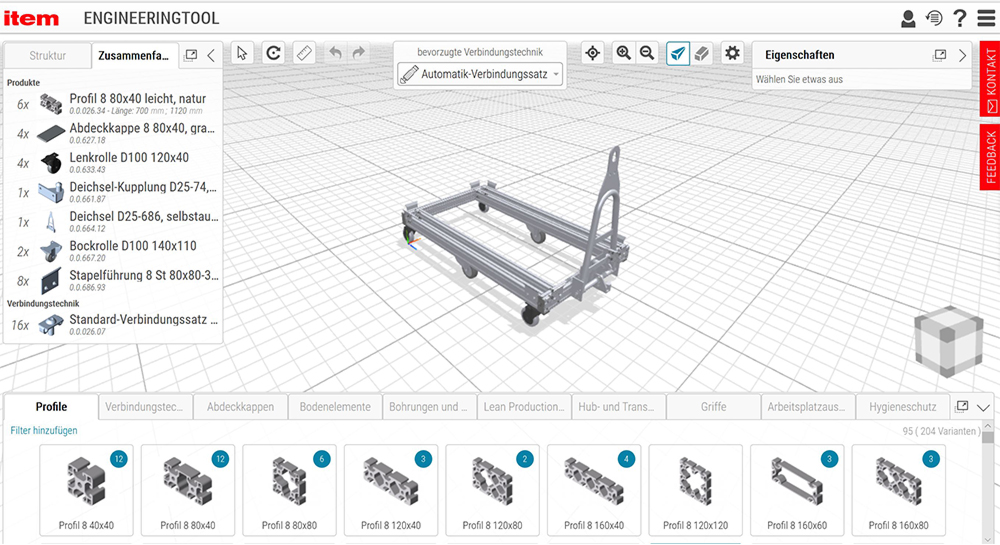
Online design for logistics made easy
The item Engineeringtool combines flexible 3D design with simple, intuitive user guidance. It can be used as a platform for the detailed design of various shapes and sizes of trailers and load carriers for tugger trains. Depending on the information provided by the user, this free online tool only offers compatible components to choose from, which reduces the risk of errors considerably. Thanks to the integrated variant technology, features of the product configuration can be changed at any time. As a result, users can easily switch from standard profiles to a design using lightweight profiles. With the item Engineeringtool, it only takes a few steps to design a frame with Swivel and Fixed Castors, Coupling, Drawbar and Stacking Guide for transporting euro pallets, for example. Other practical functions provide additional support. The measuring function, for instance, takes all the hassle out of constructing frames that match the dimensions of euro pallets perfectly.
The item Engineeringtool can be used to design superstructures, bases and frames for tugger trains in line with individual requirements.
“The item Engineeringtool enables users to quickly create a platform that can serve as the basis for designing several trailers. This is extremely convenient and saves time,” says Christian Thiel, product manager and expert for online tools with item. It is then easy to expand and modify these trailers in the tool according to requirements. In this way, users can design superstructures, bases and frames, precisely in line with their needs. The tool can even be used to create more complex Karakuri/LCA (= Low Cost Automation) projects. If any of the components clash with each other, the online tool will highlight this during the design process. What’s more, the integrated plausibility check prevents components being placed in the wrong position. However, it is not only the design process that is simplified and accelerated considerably. There is also comprehensive support in all the steps that follow, for example with automatically generated project documentation, the link to the item shop and an animated 3D assembly guide. Anyone who is looking to create leaner production processes using tugger trains will therefore find the perfect partner in item – thanks to the modular components and innovative online service.
Are you interested in fascinating reports and innovations from the world of lean production? Then we have just what you’re looking for! Simply subscribe to the item blog by completing the box at the top right.

